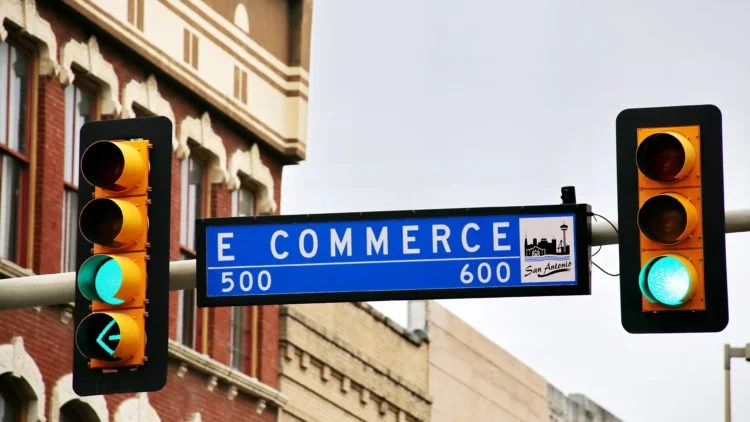
Ecommerce Quick Wins: Product Category Expansion
A major opportunity we see for a lot of eCommerce sites is expanding the number of category pages they have. Naturally, an eCommerce site will have the top-level product categories all present and correct and split those products out onto some separate sub-category pages, but a good number of businesses don’t realise that by broadening the number of sub-category pages they have on-site, they’re significantly increasing their ranking – and in turn, revenue potential.
The Too Long; Didn’t Read
- Build out additional sub-category pages
- They’re good for rankings
- Rankings = revenue
- Revenue = happiness
Why is sub-category expansion beneficial for SEO?
Google wants to surface the most relevant content it can for a user query and it wants that content to fulfil the user need. If a user searches for a bardot dress, Google knows the most satisfying search experience is to get them to a place where they can browse multiple bardot dresses, so it surfaces category pages from different eCommerce sites in its organic results.
That’s why in the top 50 I see 1 organic result that isn’t a category page and that’s a Pinterest page containing lots of different images of bardot dresses. In fact, it wants to surface category pages so much that when I search for lime green bardot dress there’s only one individual product page on the first page of Google results and it’s sitting in 9th – all the rest of the top 10 organic results are bardot dress category pages.
Google wants to surface category pages because it knows that’s what users want. Successful eComm businesses know what Google wants to show and they’ve got the product category pages to prove it.
There’s no better industry to look at than the fashion retail industry for an absolute master class in product category coverage. This doesn’t mean that none of this advice is invalid for any other eCommerce site, it is entirely valid, it’s just that fashion retailers have been doing this at scale and it’s super easy to demonstrate how and why they’re doing it.
Case in point; Boohoo has over 100 dress category pages on their site, with separate category pages for dress types, colour, material, dresses for specific body shapes and occasions etc. Boohoo aren’t unique in their approach either – they’re in direct competition with a number of other fashion retail sites who are all employing the same tactic in near identical ways:
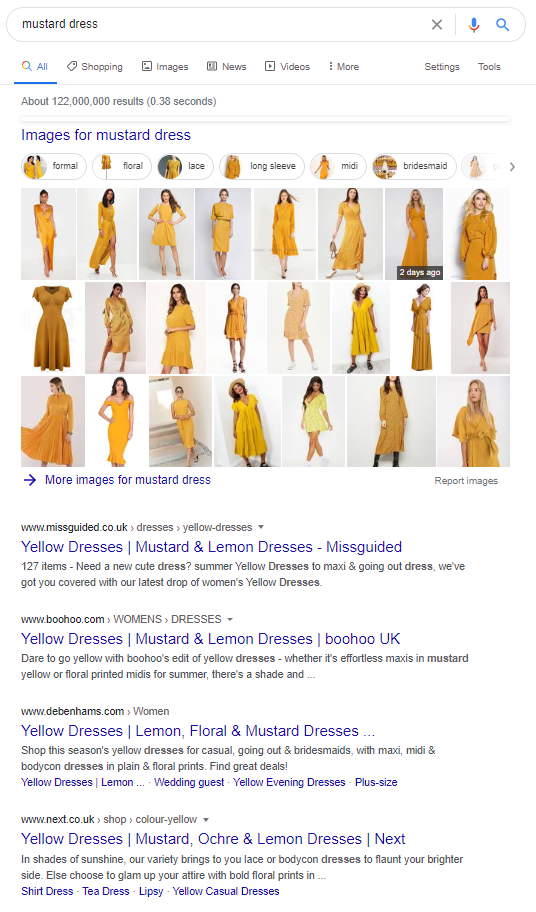
….and the reason they do is because it drives rankings, and the reason they’re after rankings is because they drive their revenue.
Specificity is key here – yes you might have high performing, technically sound top-level category pages with plenty of external links but they’re going to struggle to rank for a more specific product type vs. a lower quality category page that specifically targets that product type. If you want the opportunity to rank, you’re going to need to build out your sub-category pages.
The “when should you build a new sub-category page” checklist!
Before you start building out a gazillion new category pages on site, there are a few things you might want to consider:
- Do you have any existing category pages that could just be re-optimised to include additional target keywords? If so, do that instead!
- Is there a decent level of search demand for the product type? If not, it’s likely not the best focus of your time!
- Do you have enough products to warrant a separate category page? Use common sense! If you’ve only got a handful of products you probably don’t need a separate page!
- Are the products likely to be consistently sold and in stock on the site? You don’t want a load of pages with no products to sell hanging about the site!
- Do you have the ability to internally link to these new pages? You need to!
Do your research (keyword and competitor) before you start building out new pages, ensuring you’re putting your time into new pages that have a chance to drive a decent return for your efforts.
You might actually find that there are a number of opportunities to refine and expand keyword targeting on existing category pages without having to go through the effort of building new pages.
Depth of product range and on-going stocking of items should be a big part of your planning – yes you can build out category pages for products that are timely, but will those pages have the time to build up authority and rank vs. competing pages? What’s the plan for when you no longer have products in stock?
Then there’s internal linking – a point that’s well worth covering in a little more detail, which is why I’ve given it it’s own sub-heading, just so you know IT’S VERY IMPORTANT!!!!!!
Internal linking approaches for product sub-categories
Ensuring new sub-category pages are internally linked is essential – it means Google can easily find them and PageRank will flow to these pages – and the approach can be easy or a little more complex depending on both the number of new pages you’re adding to the site and how easy it is to set these solutions up on your site. Again, we’re using examples from the fashion industry here as the market leaders all have a solid approach to internal linking.
First and easiest solution – if you’ve got space in your main navigation, then we recommend you add internal links there if you can. If you don’t have space, make some – dump out any duplicated links and reshuffle what you’ve got to find some space.
Building out a load of new pages for products of a similar type? Consider creating a separate category in the nav for them, like Missguided have for dresses:
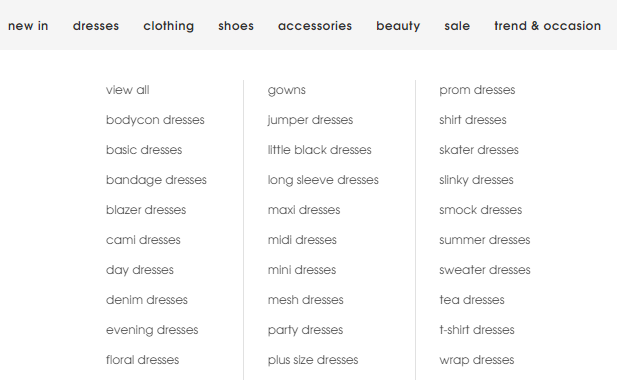
A second simple solution is to link to other category pages from your content snippets (if you don’t have content snippets on your category pages already, get them!), as Next do:

Ideal internal linking would be both of the above, plus additional internal links under the content snippet from contextually relevant pages. A number of sites do this well, Boohoo perhaps have the most extreme version of this solution in place, linking to a large number of sub-category pages from their main dresses page:
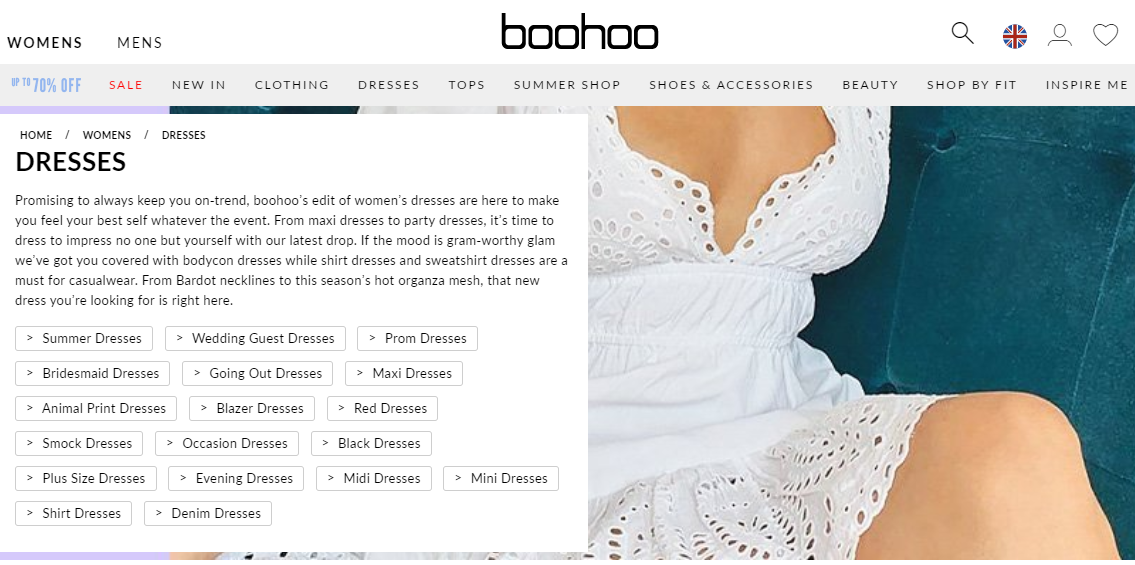
…and each sub-category page, in turn, links out to other sub-category pages:
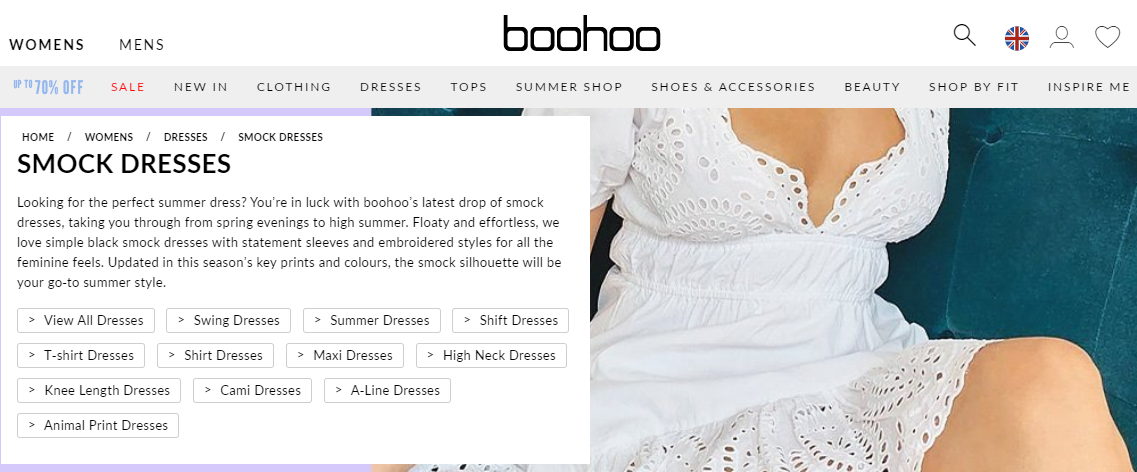
There are more ways to add internal links but these are the three approaches we’ve found work best. Use one of them or all of them but never none of them!
The Too Long; Did Read
Sub-category expansion can be an incredibly effective tool for any ecommerce site, allowing you to broaden your keyword visibility and dominate niche product types and variations. It takes a lot of planning and a bit of effort building out additional pages but, done effectively, it can result in a significant return on the time invested. The best thing about it is you already have the products on your site and you already have the category templates, so all that’s left is just to combine the two – the very definition of a quick win (apart from the extensive planning phase of course…ahem)!



